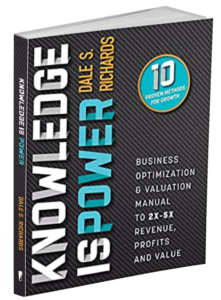Contribution Margin is a Magic Wand for Optimization
I would like you to put on your university hat on. You are back in class. It is going to be a fun class, but you are going to learn some principles that you may not have heard before, but it is going to help you begin to think about the magic wand of valuation. The poof.
You know you need a detailed plan created with novel proprietary organizational techniques to allow potential funders to see the objectives and details quickly to ensure success.
I am just going to give you a couple examples of different valuation scenarios from experience.
One: From my book Business Valuation Principles
In this first case, there are two public companies and they are pink sheets. Do you know what pink sheets are? They basically, do not have much flow. They have gone public for one reason or another to raise some money of some kind. The two public companies were talking and they really do not have much flow so it is hard to tell what value really is because it only sells every so often. Their initial discussion was trading 46 to 100 shares. But, after doing side-by-side comparison valuations, they actually traded at 34 and saved the client $5 million worth of transaction. It will only cost about twelve grand.
Two: Why go to the trouble of finding all the variable expenses and determine your contribution margin? An example is in order:
- -$1 Sales Gain @ 25% Cont. Margin = $0.25 NI
What if your marketing department came to you with a proposal that cost $1 million and said it would produce $2 million in revenue? Your Gross Margin (GM) is 60%. You might approve the project because in GM theory the project would make $1.2 million. ($2M x 60% GM = $1.2 GM profit).
HOWEVER, what if the real Contribution Margin (CM) is 50%? The proposal would just barely break-even ($2M x 50% CM = $1 million CM). Then the project would be too risky to approve.
Many CEOs have asked why a revenue-generating project with a supposed high GM, which should be making money, is actually losing money. It is because the CM is not calculated and considered in the project proposal and is much lower than the GM.
Once the CM is known, it is a magic number to determine the break-even for the company, division, project, department or other categories.
BREAK-EVEN = Fixed Expenses / CM%
__________________________________________________________
Dale Richards’ created the expansion business plan for Marian Coman Romania to grow with additional capital from 20% to 90% growth per year. In three days of joint work, a detailed plan was created with novel proprietary organizational techniques to allow potential funders to see the objectives and details quickly to ensure success. ( in limba Romana)
English version: https://youtu.be/EvY0L7YR5Ew
ABOUT DALE S. RICHARDS:
Dale S. Richards specializes in management, marketing, operation optimization & business valuation consulting and is a 30+ year turnaround expert. He has implemented success concepts into results in 150+ companies. Dale is a Certified Valuation Analyst (CVA) with NACVA, Eight-Year Vistage Chair & International Speaker.



